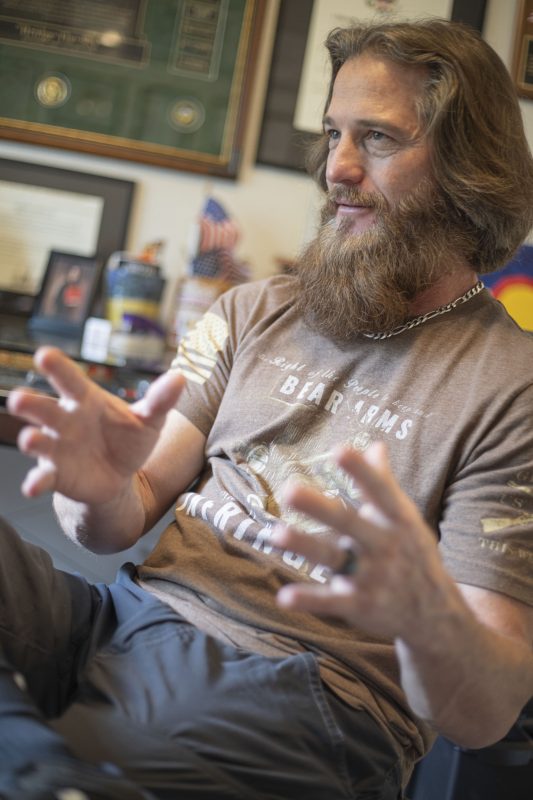For anyone who has ever known a set of twins, it’s widely believed, whether true or not, that there is some kind of telekinetic bond between them.
And when twins, or very close brothers square off, it seems to be encoded into lore.
Cain and Abel; Romulus versus Remus; King Richard vs. John; Dom DiMaggio versus Joe DiMaggio. They matter a great deal in both fiction and non-fiction because no matter how heated it becomes between the brothers’ factions, it won’t be as personal or as important as it is to them.
But what of the stories of two brothers meeting amicably on a battlefield? What of the love they share for one another transcending the war and violence around them?
And what if they were not only brothers, but also twin brothers?
Sgt. 1st Class Kimberlin Bain can answer both those questions.

Early Life
Bain and his brother Christopher were born April 24, 1971, to Richard and Michelle Bain in Oceanside.
The youngest of four siblings, the Bain twins spent the first years of their lives in San Diego, the children of a Marine and the archetype, he says, of “Marine brats.”
But while they were still young, Richard, a two-tour Vietnam veteran, made the decision to move his family north to Los Angeles and become a member of the Los Angeles Police Department. Michelle would join the force, as well.
“She’s a smaller, 5-foot redhead from hell,” Bain now jokes in reference to his mom joining the LAPD.
The family business would affect the location of the family home, said Bain. Instead of raising their kids in the jurisdiction they served, Richard and Michelle Bain took their kids to Pine Mountain, a secluded wilderness-heavy area.
“It was probably because of their job,” said Bain, in reference to why his parents didn’t want him and his siblings to grow up in Los Angeles. “They probably wanted to give us a wilderness atmosphere.”


Boxing Champion
After graduating from Hart High and doing a stint in collegiate football, Bain said he wasn’t doing much to move on with his future. He was the last remaining sibling in his home, and with no job and no classes to attend, his parents told him he would need to be doing something with his time.
And on Oct. 8, 1992, Bain made the choice to join the U.S. Army.
“I mean my dad wanted me to go into the Marine Corps, I think deep down he did,” said Bain. “But you know generations change, and from Vietnam and what he did.”
After completing his basic training, and receiving a military occupational specialty as a combat engineer, Bain was off to Germany.
“You’re construction,” said Bain, adding that he learned how to build everything from roads, to bridges to bases to obstacles for the enemy to encounter and be impeded by. “We put concertina wire out, we lay out minefields and we blow up minefields.”
However, Bain would never really be able to put these skills to practice because of his rare athleticism.
While in Germany, Bain was selected to participate as a light-welterweight boxer on both the Pan-American and German national teams. His elusiveness and counters eventually led him to becoming a full-time boxer, traveling throughout not only Europe, but also a chance to compete for a spot at an Olympic trial in the All Army Tournament in Arizona.
“And I ended up winning,” said Bain. He would go on to compete at the Olympic trials before losing. His final record, when it was all said and done, had more than 80 wins in the “W” column, and just over 10 losses.
“When I got out of the Army I stopped ’cause I got out of active duty in 1996,” said Bain.
But his time in active duty was not over once he left the Army in the ’90s, and his time battling combatants was not over the moment he left the ring.


Six Tours
Once discharged, Bain returned home to raise his family and work for the city of Los Angeles. However, still feeling a draw to the military life, he enlisted in the Army National Guard.
From 1996 to November 2003, Bain would split his time between working for the city and fulfilling his responsibilities to the National Guard. He had also gained a new MOS, and instead of training with landmines or a jump, he trained inside of an M-1 Abrams tank as a gunner.
“Insane,” said Bain, when asked to describe what it sounds like from the inside of a 60-ton tank when it fires its 105mm shell. “You’re looking in sight, you got the controls, and when you hit it … I mean the whole vehicle just goes ‘whoosh,’” he said as he rocked back in his chair.
Following the attacks of 9/11 and the United States’ decision to open up wars in both Iraq and Afghanistan, a number of Army National Guard units were called up. One of them was Bain’s.
In November 2003, he made his first arrival in the Middle East. For the next 18 months, including training, Bain would be crawling the desert in either his tank or a humvee providing artillery support or actually leaving the humvee and helping in the various “raids.”
“We would take names and do our intel,” Bain explained of the raids. “And then we always had (a list), and … we got to go get them.”
“We’d usually bring them back,” said Bain. “And (intelligence personnel) would get their intel, and let us know to go get another bad guy.”
Both while in the M-1 and while in the Humvee, Bain said improvised explosive devices, or IEDs, were a regular staple in their lives.
“You’re in the tank and you’re protected, and we’d get hit and I’d be like, ‘What the hell was that?’”
“An IED.”
“‘Cool. Keep going,’” he’d respond.
That wasn’t the case for the Humvee, a lesson he would soon learn.


A Chance Encounter
One day, during his first year in Iraq, Bain would have a storybook encounter. While leaving his base in his M-1, a convoy of humvees was returning. According to Bain, this was always a slow process, because he would need to wait as the soldiers in the humvees would always want to take photos.
After he had enough of the sitting around in 140-degree heat and full combat gear, the gunner became agitated, waving his fellow soldiers along. And this is when one of the convoy drivers stopped in his path.
“He’s just looking (at the tank) and I put my hands up and I’m like, ‘Dude, take a picture and move on,’” Bain said, adding that he then gave a universal hand gesture to the driver after more delay. “This guy ends up coming up and throwing a rock at my helmet.”
Bain said he took off his helmet, and superior officer be damned, the boxer in him was about to come out.
“I jumped down,” said Bain. “And he’s like, ‘Bro!’”
It was his twin brother, Christopher.
The two twins found each other on the other side of the world, each not knowing where the other was in terms of their tour. And on a beaten down road in Iraq, with the sun bearing down and dust kicking up in the air, they happened to pass one another.
Bain said he and his brother would be allowed to hang out with one another for a few hours, before they were called back to their responsibilities.
“He’s like, ‘I’ll see you next week,’ and I’m like, ‘sweet,’” remembered Bain.
They hugged and parted ways. And it would be the last time they spoke to one another in Iraq.
A few hours later, in a convoy, Christopher and his Humvee were hit during an ambush.
“He was on his way back,” said Bain. “He suffered from nerve damage in both his arms.”
“We call him ‘T-Rex’ now,” Bain now jokes. “Because he’s got a big mouth and two arms he can’t do stuff with.”
But like many twins, what happens to one happens to the other.
A few months later, an IED on one of the highways hit Bain’s humvee. Everyone in the vehicle had to regain consciousness and fight off the incoming enemy fire.
Bain, much like his brother, survived the attack. But it cost him his hearing in one ear.


Retired
After serving a total of six tours in the Middle East, Bain was honorably discharged as a heavily decorated E-7 Sergeant First Class. From October 1992 to April 2018, he served 14 years of active duty service and completed tours in Iraq from 2003-05; Iraq from 2007-08; and Afghanistan from 2013-14.
Before being discharged, Bain had planned on completing a seventh tour. But during the medical evaluation process to send him back, a doctor discovered a growth near the ear in which he no longer had hearing.
“They said it was the size of a tennis ball,” he said. Although benign, the tumor had likely been growing since the day he was ambushed and wounded. He never thought to ask about his deteriorating balance or growing clumsiness.
After the surgery, Bain returned home to Santa Clarita, where he now lives with his wife and family. At the age of 47, he is enrolled at College of the Canyons in hopes of completing his associate’s degree and moving into construction management.
“Now,” Bain said, “I just enjoy my life one day at a time.”.









